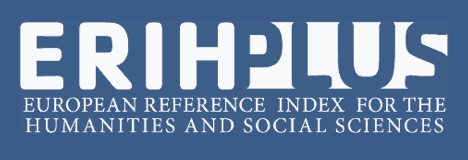ENVIRONMENTAL CHARACTERIZATION AND MORPHOMETRIC ANALYSIS OF ITAUEIRA RIVER WATER BASIN, PIAUÍ, BRAZIL
Abstract
The study aimed to perform geoenvironmental characterization, particularly morphometric, of the Itaueira River Basin, state of Piauí, from geometric variables, drainage network and relief, as a possibility to know the environmental dynamics of the basin. For this purpose it used the Digital Elevation Model (DEM) to calculate the morphometric parameters related to the geometric characteristics, drainage network and relief. Thus, the study indicated that the basin area studied is 10122.4 km2 and a perimeter of 757.03 km2. In turn, the basin has an elongated profile and low predisposition to abrupt flooding, as its compactness coefficient is 2.1068, form factor 0.12 and circularity index of 0.222. The total length of the watercourses is 735.2 km, drainage density 0.073 km/km², hydrographic density 0.0014 and 3rd order river channels. The altitude and average slope found were 371.7 m and 4.81%, respectively, while its roughness index was 44.238.
References
BARRELLA, W.; PETRETE JR., M.; SMITH, W.S.; MONTAG, L.F.A. As relações entre as matas ciliares os rios e os peixes. In: RODRIGUES, R.R.; LEITÃO FILHO; H.F. (Ed.). Matas ciliares: conservação e recuperação. 2. ed. São Paulo: Editora da Universidade de São Paulo, 2001.
CHRISTOFOLETTI, A. Análise morfométrica de bacias hidrográficas. Rev. Geomorfologia, Campinas, v.18, n.9, p.35-64, 1969.
COMPANHIA DE PESQUISA DE RECURSOS MINERAIS. Ministério de Minas e Energia. Mapa Geológico do Estado do Piauí. 2. ed. 2006a.
________. Mapas Estaduais de geodiversidade: Piauí. Rio de Janeiro: CPRM. 2006b. Documento cartográfico em arquivo vetorial. Disponível em:
________. Programa de água subterrânea para o semiárido brasileiro. CPRM/SGB, 2004
EMPRESA BRASILEIRA DE PESQUISA AGROPECUÁRIA. Centro Nacional de Pesquisa de Solos. Sistema brasileiro de classificação de solos. Rio de Janeiro: EMBRAPA-SPI, 2009.
HORTON, R.E. Erosional development of streams and their drainage basins: hidrophysical approach to quantitative morphology. Geological Society of America Bulletin, v.56, p.807-813, 1945.
JACOMINE, P.K.T. Mapa exploratório-reconhecimento de solos do estado do Piauí. Convênio EMBRAPA/SNLCS-SUDENE-DRN. 1983.
LIMA, W.P. Princípios de manejo de bacias hidrográficas. Piracicaba: ESALQ/USP, 1976.
PIAUÍ. Secretaria do Meio Ambiente e dos Recursos Hídricos do Estado do Piauí (SEMAR/PI). Relatório Síntese do Plano Estadual de Recursos Hídricos do Estado do Piauí- PERH. 2010.
PORTO, M.F.A.; PORTO, R.L. Gestão de bacias hidrográficas. Estudos Avançados, v. 22, n.63, 2008.
NIMER, E. Climatologia do Brasil. Rio de Janeiro: IBGE, 1979. 422 p.
SANTOS, F.A. Mapeamento das unidades geoambientais e estudo do risco de degradação/desertificação nos municípios de Castelo do Piauí e Juazeiro do Piauí. 2015.187f. Dissertação (Mestrado em Geografia) – Universidade Federal do Piauí, Teresina, 2015.
TEODORO, V.L.I.; TEIXIERA, D.; COSTA, D.J.L.; FULLER, B.B. O conceito de bacia hidrográfica e a importância da caracterização morfométricas para o entendimento da dinâmica ambiental local. Revista UNIARA, n.20, 2007.
TONELLO, K.C. Análise hidroambiental da bacia hidrográfica da cachoeira das Pombas, Guanhães, MG. 2005. 69f. Tese (Doutorado em Ciências Florestal) – Universidade Federal de Viçosa, Viçosa, 2005.
UNITED STATES GEOLOGICAL SERVICE (Serviço Geológico dos Estados Unidos). Earth Explorer - Collection- Landsat Archive. Disponível em:

This work is licensed under a Creative Commons Attribution-NonCommercial 4.0 International License.
Policy Proposal for Free Access Journals
Authors who publish in this journal agree to the following terms:
a. Authors retain the copyright and grant the journal the right of first publication, with the work simultaneously licensed under the Creative Commons Attribution License which allows the sharing of the work with acknowledgment of the authorship of the work and initial publication in this journal.
b. Authors are authorized to take additional contracts separately, for non-exclusive distribution of the version of the work published in this journal (eg publish in institutional repository or as a book chapter), with acknowledgment of authorship and initial publication in this journal.
c. Authors are allowed and encouraged to publish and distribute their work online (eg in institutional repositories or on their personal page) at any point before or during the editorial process, as this can generate productive changes, as well as increase the impact and The citation of published work (See The Effect of Free Access).





















